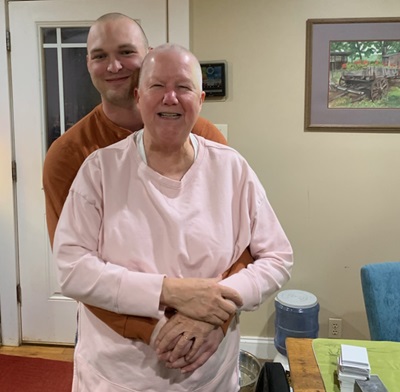 For the past 30 years, Susan Stancil has lived with essential tremor symptoms in both hands. At first, medication kept her tremors under control. But over the past few years, her symptoms worsened to the point where they affected her quality of life.
For the past 30 years, Susan Stancil has lived with essential tremor symptoms in both hands. At first, medication kept her tremors under control. But over the past few years, her symptoms worsened to the point where they affected her quality of life.
“My eating and writing were most affected,” says Susan. “It had reached a point where it impacted what I could order in a restaurant, such as soup. I couldn’t drink a beverage without using both hands and my friends worried about me injuring myself while chopping vegetables.”
Essential tremor is a progressive neurological disorder that causes an involuntary shaking movement, most often affecting a person’s limbs, head, trunk or voice. Anxiety or stress can make symptoms worse.
The condition affects approximately 1 million people in the United States. Of those diagnosed, about 30% have a family history of essential tremor. In Susan’s family, both her father and younger sister were diagnosed with the condition.
Susan’s primary neurologist prescribed medication to manage the tremors, but eventually, her symptoms weren’t well-controlled with this treatment approach. Her neurologist referred her to Dr. Adrian Laxton, a neurosurgeon and the director of Stereotactic and Functional Neurosurgery at Atrium Health Wake Forest Baptist.
Focused ultrasound to treat essential tremor
Susan met with Dr. Laxton, who recommended a treatment called focused ultrasound to treat her essential tremor.
“Ms. Stancil was a good candidate for focused ultrasound because she has medication refractory essential tremor,” says Laxton. “That means that, despite medication, she had a tremor that interfered with her ability to eat, drink, write and do activities she enjoys, such as gardening.”
In December 2024, Susan underwent a left brain-focused ultrasound procedure to treat her right-sided tremor.
Focused ultrasound is an incision-free, radiation-free treatment that treats hand tremors caused by essential tremor or Parkinson’s disease. It’s an outpatient procedure and gives patients life-changing relief in just a few hours.
During the procedure, a neurosurgeon uses magnetic resonance imaging (MRI) to guide focused ultrasound waves to the area of the brain that controls the tremor. The ultrasound waves safely and precisely heat and remove the brain cells related to tremor symptoms without damaging surrounding tissue.
“Focused ultrasound is a safe and highly effective minimally invasive treatment for tremor that is life-changing for patients,” says Laxton. “Being able to offer focused ultrasound to patients with tremors is one of the most satisfying and rewarding parts of my neurosurgical practice.”
The difference between focused ultrasound and deep brain stimulation
Both focused ultrasound and deep brain stimulation can be used to treat hand tremors caused by essential tremor or Parkinson’s disease. Focused ultrasound is an incision-free, minimally invasive procedure, while deep brain stimulation requires opening the skull.
Who is a good candidate for focused ultrasound?
Focused ultrasound can be a good option for individuals with hand tremors related to essential tremor or Parkinson’s disease that don’t respond to medication. While it has been shown to provide immediate relief of symptoms, it may not completely resolve tremors in all patients and it doesn’t treat the underlying cause of tremors.
“Patients who have had deep brain stimulation in the past are not able to undergo focused ultrasound,” says Laxton. “However, patients who have had focused ultrasound in the past may be candidates for repeat focused ultrasound or deep brain stimulation if desired.”
What to expect during a focused ultrasound procedure
“I was awake for the entire treatment and it was completely outpatient,” says Susan. “My appointment was at noon and I live about an hour and fifteen minutes from the hospital. I was home by 4 p.m.”
Each ultrasound wave lasted about 10 to 15 seconds. After each round, Susan’s medical team had her practice writing her name and drawing a swirl shape on a piece of paper. With each round, her writing and drawing skills improved.
Laxton recommended four rounds for Susan to resolve her right-sided tremor. During the procedure, Susan experienced minor side effects like temporary dizziness and pressure in her head that felt “intense and uncomfortable, but not painful.” She said the only downside of the focused ultrasound was having her head shaved, but she says it was worth it to resolve her tremor.
Susan’s recovery and improved quality of life
“After the procedure there was no recovery period—I got to experience instant gratification,” says Susan.
She will need to undergo a separate procedure for her left-sided tremor.
“Susan has experienced a complete resolution of her previous right arm tremor as a result of her focused ultrasound treatment,” says Laxton.
Susan’s results should last for at least several years.
“We now have good evidence through well-designed, multi-center studies that the effective reduction of tremor with focused ultrasound can last for at least five years or longer,” says Laxton.
For Susan, this means getting back to activities she enjoys and consuming her meals and drinks with less worry.
“I’m now able to drink a cup of coffee with one hand, a feat I haven’t achieved in the past 20 years,” she says. “I can open the sugar container and easily put one spoonful in my coffee without spilling it all over the countertop like before. I can write a grocery list and read my handwriting. It’s wonderful now to ask what the soup of the day is when I go to a restaurant.”
Learn more about focused ultrasound for essential tremor at Atrium Health Wake Forest Baptist.
